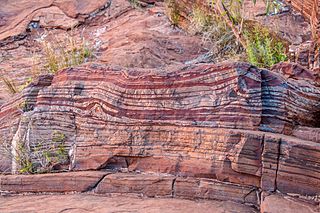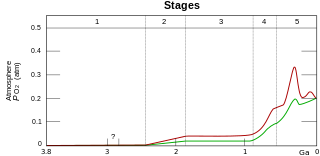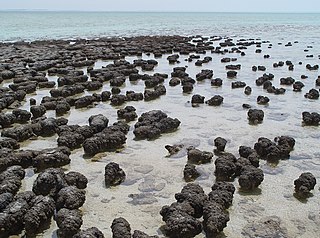Related Research Articles
Nitrogen fixation is a chemical process by which molecular nitrogen (N
2), with a strong triple covalent bond, in the air is converted into ammonia (NH
3) or related nitrogenous compounds, typically in soil or aquatic systems but also in industry. Atmospheric nitrogen is molecular dinitrogen, a relatively nonreactive molecule that is metabolically useless to all but a few microorganisms. Biological nitrogen fixation or diazotrophy is an important microbially mediated process that converts dinitrogen (N2) gas to ammonia (NH3) using the nitrogenase protein complex (Nif).

Oxygen is the chemical element with the symbol O and atomic number 8. It is a member of the chalcogen group in the periodic table, a highly reactive nonmetal, and an oxidizing agent that readily forms oxides with most elements as well as with other compounds. Oxygen is Earth's most abundant element, and after hydrogen and helium, it is the third-most abundant element in the universe. At standard temperature and pressure, two atoms of the element bind to form dioxygen, a colorless and odorless diatomic gas with the formula O
2. Diatomic oxygen gas currently constitutes 20.95% of the Earth's atmosphere, though this has changed considerably over long periods of time. Oxygen makes up almost half of the Earth's crust in the form of oxides.

Photosynthesis is a process used by plants and other organisms to convert light energy into chemical energy that, through cellular respiration, can later be released to fuel the organism's activities. Some of this chemical energy is stored in carbohydrate molecules, such as sugars and starches, which are synthesized from carbon dioxide and water – hence the name photosynthesis, from the Greek phōs, "light", and sunthesis, "putting together". Most plants, algae, and cyanobacteria perform photosynthesis; such organisms are called photoautotrophs. Photosynthesis is largely responsible for producing and maintaining the oxygen content of the Earth's atmosphere, and supplies most of the energy necessary for life on Earth.

The Proterozoic is a geological eon spanning the time interval from 2500 to 538.8 million years ago. It is the most recent part of the Precambrian "supereon." It is also the longest eon of the Earth's geologic time scale, and it is subdivided into three geologic eras : the Paleoproterozoic, Mesoproterozoic, and Neoproterozoic.

The Archean Eon is the second of four geologic eons of Earth's history, representing the time from 4,000 to 2,500 million years ago. In this time, the Earth's crust had cooled enough for continents to form and for the earliest known life to start. Life was simple throughout the Archean, mostly represented by shallow-water microbial mats called stromatolites, and the atmosphere lacked free oxygen. The Archean was preceded by the Hadean Eon and followed by the Proterozoic.

Cyanobacteria, also known as Cyanophyta, are a phylum of Gram-negative bacteria that obtain energy via photosynthesis. The name cyanobacteria refers to their color, giving them their other name, "blue-green algae", though modern botanists restrict the term algae to eukaryotes and do not apply it to cyanobacteria, which are prokaryotes. They appear to have originated in freshwater or a terrestrial environment. Sericytochromatia, the proposed name of the paraphyletic and most basal group, is the ancestor of both the non-photosynthetic group Melainabacteria and the photosynthetic cyanobacteria, also called Oxyphotobacteria.

An atmosphere is a layer of gas or layers of gases that envelope a planet, and is held in place by the gravity of the planetary body. A planet retains an atmosphere when the gravity is great and the temperature of the atmosphere is low. A stellar atmosphere is the outer region of a star, which includes the layers above the opaque photosphere; stars of low temperature might have outer atmospheres containing compound molecules.
A reducing atmosphere is an atmospheric condition in which oxidation is prevented by removal of oxygen and other oxidizing gases or vapours, and which may contain actively reducing gases such as hydrogen, carbon monoxide, and gases such as hydrogen sulfide that would be oxidized by any present oxygen. Although early in its history the Earth had a reducing atmosphere, it now instead has an oxidizing atmosphere with molecular oxygen (dioxygen, O2) as the primary oxidizing agent.
The Mesoarchean is a geologic era in the Archean Eon, spanning 3,200 to 2,800 million years ago, which contains the first evidence of modern-style plate subduction and expansion of microbial life. The era is defined chronometrically and is not referenced to a specific level in a rock section on Earth.

Geobiology is a field of scientific research that explores the interactions between the physical Earth and the biosphere. It is a relatively young field, and its borders are fluid. There is considerable overlap with the fields of ecology, evolutionary biology, microbiology, paleontology, and particularly soil science and biogeochemistry. Geobiology applies the principles and methods of biology, geology, and soil science to the study of the ancient history of the co-evolution of life and Earth as well as the role of life in the modern world. Geobiologic studies tend to be focused on microorganisms, and on the role that life plays in altering the chemical and physical environment of the pedosphere, which exists at the intersection of the lithosphere, atmosphere, hydrosphere and/or cryosphere. It differs from biogeochemistry in that the focus is on processes and organisms over space and time rather than on global chemical cycles.

The Siderian Period is the first geologic period in the Paleoproterozoic Era and lasted from 2500 Ma to 2300 Ma. Instead of being based on stratigraphy, these dates are defined chronometrically.

Algal mats are one of many types of microbial mat that forms on the surface of water or rocks. They are typically composed of blue-green cyanobacteria and sediments. Formation occurs when alternating layers of blue-green bacteria and sediments are deposited or grow in place, creating dark-laminated layers. Stromatolites are prime examples of algal mats. Algal mats played an important role in the Great Oxidation Event on Earth some 2.3 billion years ago. Algal mats can become a significant ecological problem, if the mats grow so expansive or thick as to disrupt the other underwater marine life by blocking the sunlight or producing toxic chemicals.
The Huronian glaciation was a period where several ice ages occurred during the deposition of the Huronian Supergroup. The deposition of the Huronian extended from 2.5 billion years ago (Gya) to 2.2 Gya, during the Siderian and Rhyacian periods of the Paleoproterozoic era. This led to the deposition of several diamictites. They are, from the oldest to youngest, the Ramsay, Bruce, and Gowganda Formations. This was not a time of continuous glaciation. Most of the deposits of the Huronian are typical passive margin deposits in a marine setting. Although the glaciations were expected to be extensive, there's no solid evidence as of yet, that it was a snowball Earth scenario. The diamictites within the Huronian are on par in thickness with Quaternary analogs. The term Huronian is a lithostratigraphic supergroup and should not be used to describe glacial cycles. The North American Stratigraphic Code, defines the proper naming of geologic physical and chrono units. Diachronic or geochronometric units should be used. Evidence for this early ice age comes from glacial deposits identified within stratigraphic record the Huronian Supergroup. Within it are three distinct formations of diamictite. Although there are other glacial deposits recognized throughout the world, the Huronian is restricted to the North American Midwest. Other deposits are known from South Africa. The Huronian glaciation broadly coincides with the Great Oxygenation Event (GOE), a time when increased atmospheric oxygen decreased atmospheric methane. The oxygen combined with the methane to form carbon dioxide and water, reducing the efficacy of the greenhouse effect as water precipitated out of the air. The combination of increasing free oxygen and climatic stresses likely caused an extinction event, the first and longest lasting in the Earth's history.

The Great Oxidation Event (GOE), also called the Great Oxygenation Event, the Oxygen Catastrophe, and the Oxygen Crisis, was a time interval when the Earth's atmosphere and the shallow ocean first experienced a rise in the amount of oxygen. This occurred approximately 2.4–2.0 Ga (billion years ago), during the Paleoproterozoic era. Geological, isotopic, and chemical evidence suggests that biologically-produced molecular oxygen (dioxygen, O2) started to accumulate in Earth's atmosphere and changed it from a weakly reducing atmosphere practically free of oxygen into an oxidizing atmosphere containing abundant oxygen.

The Hamelin Pool Marine Nature Reserve is a protected marine nature reserve located in the UNESCO World Heritage–listed Shark Bay in the Gascoyne region of Western Australia. The 127,000-hectare (310,000-acre) nature reserve boasts the most diverse and abundant examples of living marine stromatolites in the world, monuments to life on Earth over 3,500 million years BP.

A microbial mat is a multi-layered sheet of microorganisms, mainly bacteria and archaea, and also just bacterial. Microbial mats grow at interfaces between different types of material, mostly on submerged or moist surfaces, but a few survive in deserts. A few are found as endosymbionts of animals.

An autotroph or primary producer is an organism that produces complex organic compounds using carbon from simple substances such as carbon dioxide, generally using energy from light (photosynthesis) or inorganic chemical reactions (chemosynthesis). They convert an abiotic source of energy into energy stored in organic compounds, which can be used by other organisms. Autotrophs do not need a living source of carbon or energy and are the producers in a food chain, such as plants on land or algae in water. Autotrophs can reduce carbon dioxide to make organic compounds for biosynthesis and as stored chemical fuel. Most autotrophs use water as the reducing agent, but some can use other hydrogen compounds such as hydrogen sulfide.
The Boring Billion, otherwise known as the Barren Billion, the Dullest Time in Earth's History, and Earth's Middle Ages, is the time period between 1.8 and 0.8 billion years ago (Gya) spanning the middle Proterozoic eon, characterized by more or less tectonic stability, climatic stasis, and slow biological evolution. It is bordered by two different oxygenation and glacial events, but the Boring Billion itself had very low oxygen levels and no evidence of glaciation.

The evolution of bacteria has progressed over billions of years since the Precambrian time with their first major divergence from the archaeal/eukaryotic lineage roughly 3.2-3.5 billion years ago. This was discovered through gene sequencing of bacterial nucleoids to reconstruct their phylogeny. Furthermore, evidence of permineralized microfossils of early prokaryotes was also discovered in the Australian Apex Chert rocks, dating back roughly 3.5 billion years ago during the time period known as the Precambrian time. This suggests that an organism in of the phylum Thermotogota was the most recent common ancestor of modern bacteria.
Photoautotrophs are organisms that use light energy and inorganic carbon to produce organic materials. Eukaryotic photoautotrophs absorb energy through the chlorophyll molecules in their chloroplasts while prokaryotic photoautotrophs use chlorophylls and bacteriochlorophylls present in their cytoplasm. All known photoautotrophs perform photosynthesis. Examples include plants, algae, and cyanobacteria.
References
- 1 2 Palmer, Douglas; et al. (2009). Prehistoric Life: The Definitive Visual History of Life on Earth (first American ed.). New York City: DK Publishing. p. 59. ISBN 978-0-7566-5573-0.